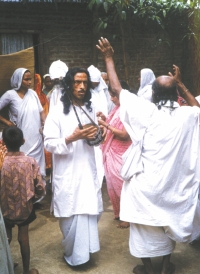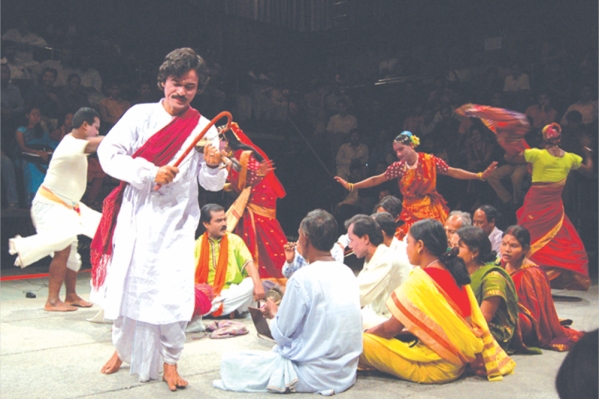Cover Story

Cultural Diversity of Rural Bangladesh
Bangladesh is one of the SAARC countries which is rich in fostering folklore. Thousand years old affluent and multi-dimensional history of folklore functions are held annually in this country. But, while discussing the history of Bengali folklore, one will find a very close relationship between Bangladesh and other SAARC countries.
......................................................................
Saymon Zakaria
 Charyageeti, followed by the Buddhists, was a text of functioning folklore in ancient Bangladesh. It was performed in the form of Buddha Natak through songs, dances, music and theatrics across villages and Buddha Bihars. However, Bangladesh had consequently gone under rule of the Hindu Sen dynasty. The Buddhists at the time were bound to flee to Nepal to save their traditional identity symbolized by Buddha Natak. Even today, we find the songs, dances and theatrics based on Charyageeti in Nepal. A direct similarity can be drawn between the masks used in Charya dance and songs in Nepal, and the masks on the terracotta inscribed upon exterior walls of Somapur Bihara built in the eighth century in Bangladesh. We can thus certainly accept the performance of Buddhist dance and songs in Nepal as the continuation of the characteristic used in materials for performance in the ancient dance and song performances here in Bangladesh. The first document of Bangla literature, the manuscript of Charyageeti or Charyapada, was discovered from the library of the king's palace in Nepal. Studying the uniqueness of the practice of Bengali Buddhist performers in Nepal, we can comment that folklore or popular culture never became extinct, rather, it exists somewhere in the world maybe in the form of an adapted local culture. Those who carry on the folk culture for centuries are common people, artists or performers. But, often, this truth remains hidden because of lack of sincere research and how some of the researchers, without gathering proper information, declare a form of folklore dead, while it is in fact still practiced. Charyageeti, followed by the Buddhists, was a text of functioning folklore in ancient Bangladesh. It was performed in the form of Buddha Natak through songs, dances, music and theatrics across villages and Buddha Bihars. However, Bangladesh had consequently gone under rule of the Hindu Sen dynasty. The Buddhists at the time were bound to flee to Nepal to save their traditional identity symbolized by Buddha Natak. Even today, we find the songs, dances and theatrics based on Charyageeti in Nepal. A direct similarity can be drawn between the masks used in Charya dance and songs in Nepal, and the masks on the terracotta inscribed upon exterior walls of Somapur Bihara built in the eighth century in Bangladesh. We can thus certainly accept the performance of Buddhist dance and songs in Nepal as the continuation of the characteristic used in materials for performance in the ancient dance and song performances here in Bangladesh. The first document of Bangla literature, the manuscript of Charyageeti or Charyapada, was discovered from the library of the king's palace in Nepal. Studying the uniqueness of the practice of Bengali Buddhist performers in Nepal, we can comment that folklore or popular culture never became extinct, rather, it exists somewhere in the world maybe in the form of an adapted local culture. Those who carry on the folk culture for centuries are common people, artists or performers. But, often, this truth remains hidden because of lack of sincere research and how some of the researchers, without gathering proper information, declare a form of folklore dead, while it is in fact still practiced.
I had presented an article on Bangladeshi folklore 'Shong', some three to four years back, in the 31st international seminar organized by UNESCO & International Theater Institute. Consequently, Nepali researcher Prof. Ovi Subedi, invited to the same seminar, mentioned some of the similarities between folklore practiced in Bangladesh and Nepal, which are cited in my paper as well. If examples are drawn, then we can observe that the Bangladeshi people celebrate Choitra Shongkranti during the last three days of the Bengali calendar. Villagers in this ceremony disguise themselves as mythical characters like Shib-Parboti, Radha-Krisna, Baiddya-Baiddyani etc. and traverse through villages. Similarly, Nepali people celebrate by welcoming the New Year and by saying goodbye to it with the Year Ending Festival. There is more scope of comparative study in this area, but, that is beside the point. Though we cannot trace back to how acting based on Charya in the mainstream population of recent Bangladesh had started, we can still find the ethnic communities like Marma and Chakma of the Buddhist religion practice Buddha Natak like Gengkhuligeet, Siddharther Grihateg (Shiddharth Leaving Home), Marma Ja etc. Considering this, there is a great cultural accord between Nepal and Bangladesh from time immemorial. Moreover, Bangladeshi folklore has cultural harmony in line with those of India and Myanmar.

The harmony between the practice of folklore of Bangladesh and the mentioned two countries was once very profound and I think it is a present need to research and identify the unity from new perspectives. This is important because, like other SAARC countries, rural Bangladesh enjoys epic performances based on Ramayana, Mahabharata and other mythical epics all the year round. As Ramayana, in the form of folklore, is acted across rural India in Tamil, Telegu, Marathi, Oria, and Ohamia languages, similarly, folk performances like 'Ramamongol', `Ramalila', 'Kushangaan', 'Ramakirtan', 'Ramajatra', 'Dhhopjatra' etc. based on Ramayana are performed in the regions of Kushtia, Rajshahi, Dinajpur, Lalmonirhat, Rangpur, Kurigram, Sylhet, Dhaka, Mymensing, Khulna, Gopalganj, and Faridpur in Bangladesh. But we know that Ramayana based cultures are not limited within the greater Indian sub-continent; it also exists in Nepal, Srilanka, Bhutan, and the Maldives. We can find cultural accord among the SAARC countries in this manner.
Bangladeshi folklore artists Boisnab Kirtanias vividly describe Mathura, the birthplace of Krishna and Brindaban and the place for Krishnaleela, in their performance of Leelakirtan. The performance shows how division between nations or states disappears through folklore practice. In the same way Bangladeshi folklore artists do not forget mentioning Sri Choitannya Nittyananda Adaitya's holy lands Nabodip, Nadia, Nilachal etc. in Krisnajatra, Krisnalila, and Sufi songs. Bangladesh once shared strong cultural communications with Myanmar. Chittagong previously used to be under Arakan, Myanmar (previously known as Burma) in the 10th Christian century. At that time, the inhabitants of Chittagong use to travel to Ararkan for jobs, business and to earn a livelihood. This was the introduction period of cultural exchange between Bangladesh and Myanmar. The Bengali poet laureates of Middle Ages Doulat Kaji and Alaoal had created immortal epics such as the 'Sati-Mayna', 'Lor-Chandrani', 'Padmabati', 'Soyfulmuluk Badiujjamal' etc. with the patronization of Arakan kings. The stories of these epics became so popular that they turned into folk performances and were acted in the form of 'Kichhagaan', 'Palagaan', 'Jatra' etc. in rural Bangladesh.

On the other hand, being a Muslim country, Bangladesh exposes a trait of Islamic Culture. Among the Islamic folklore, there is Tazia of Muharram, mournful Jarigaan etc. In addition, there are different forms of Sufi Songs that have intense similarity with those of India and Pakistan. One of the forms of Pakistani Kaoali is very popular in the old Dhaka city area. Hasan and Hossain, the grandsons of Hazrat Muhammad (peace be upon him), gave their lives along with other family members in Karbala sometime during the Arabic month of Muharram in the Arabic year of 10th Hijri. Commemorating their deaths, the people of Dhaka, Manikganj and Mymensing bring out Tazia processions every year. The same culture is prevalent in India and Pakistan. The Kalapahar, graves of Hasan and Hossain, red flags, kara-nakara, knives, swords, metal helmets of Qaseds, armors etc. are used in the procession of Tazia in Ahmedabad of India, Lahore of Pakistan and in Bangladesh as well during the Arabic month of Muharram. Though Bangladeshis and Pakistanis are mostly Muslims and Indians are mostly Hindus, they have the same folklore practices. It is equally true about the Hindu or Boisnab culture in Bangladesh and India. Similarly, the Hindus of both India and Bangladesh celebrate Holly and Rashleela. It is remarkable that Bangladeshi Muslims and the followers of other religions also take part in the celebration of Holly and Rashleela. This is well portrayed by the photograph, captured by my friend and acclaimed photo-journalist Shahadat Parvez, which shows how in a gathering of Hindu women, during their festival of Holly, standing in front of one of their deities in prayers with clasped hands is accompanied by a Muslim woman in the Hijab holding out her hands in prayers following the practiced Muslim custom. The picture was taken in front of the Radha-Krishna temple located in Shakharipara in old Dhaka. I personally believe this picture to be proof of historical religious mutuality in Bangladesh.
One other example can be found as to how Bauls all over the world find Bangladesh as the place for pilgrimage. This is nothing astounding, as Bangladesh had been his Lalon Shah's of birth and death. Even then, places such as Nadia, Birbhum, Bakura, Chabbishpargana in India are also considered holy places by the Bauls.
Finally, a common feature found in the knowledge, songs, dances and tunes of the folklore practices in the greater folklore or popular culture of the SAARC countries show they are passed on to disciples one generation to another by Gurus. There exists no institutional base of such folk education like the colonial knowledge practices. This may be the reason why the folklore of the SAARC countries hardly attracts the educated under colonial institutes. But I believe that only the thousands of years' old folklore of the SAARC countries has the potential of establishing unity among South Asian countries.
Copyright
(R) thedailystar.net 2011
|
|


 C
C
